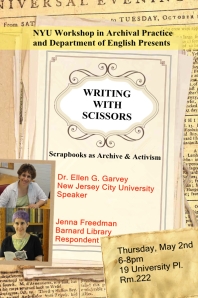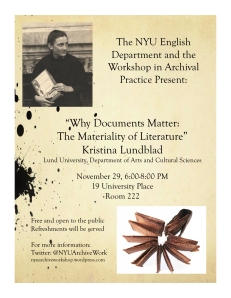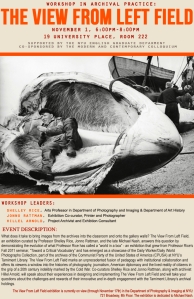 It is with great excitement that we invite you to our upcoming workshop with Ellen Gruber Garvey, Professor of English and Women’s and Gender Studies at New Jersey City University and the author of a new book, Writing With Scissors: American Scrapbooks from the Civil War to the Harlem Renaissance (Oxford UP, 2012). Please join us on May 2, 6:00-8:00 PM at 19 University Place, Room 222. The event is free and open to the public and refreshments will be served.
It is with great excitement that we invite you to our upcoming workshop with Ellen Gruber Garvey, Professor of English and Women’s and Gender Studies at New Jersey City University and the author of a new book, Writing With Scissors: American Scrapbooks from the Civil War to the Harlem Renaissance (Oxford UP, 2012). Please join us on May 2, 6:00-8:00 PM at 19 University Place, Room 222. The event is free and open to the public and refreshments will be served.
Professor Garvey will present from her work in a talk entitled “Writing With Scissors: Scrapbooks as Archive & Activism” and Jenna Freedman, Director of Research & Instruction and Zine Librarian at Barnard Library, will offer a response. As is our custom, a good deal of time will be devoted to workshop-style discussion, so please bring your questions! We promise our speakers will stimulate your curiosity about a wide range of topics, including what scrapbooks (and scrapbook-makers) can reveal to us about U.S. literary, political and cultural histories and of course, about archives & activism.
For more information about Writing With Scissors, check out Christopher Benfey’s “Scrapbook Nation” post at the New York Review of Books blog here. You can also read more about Jenna Freedman’s work at her blog, Lower East Side Librarian.
We look forward to seeing you on May 2! Stay tuned on Twitter @NYUArchiveWork for news, updates and future announcements.




